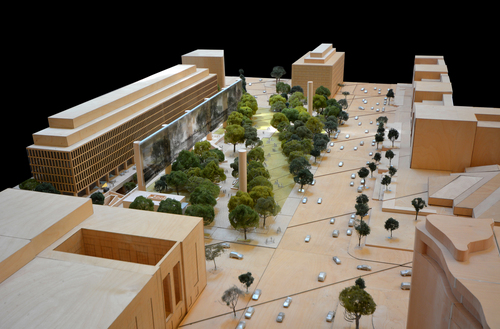Gehry trims Eisenhower Memorial tapestries
Architect Frank Gehry and the National Capital Planning Commission continue to tweak designs for the proposed Eisenhower Memorial. The latest change removes two of the three metal tapestries that had largely defined the original proposal.
The new design is the product of negotiation between Gehry and NCPC, who last April declined to approve the plans, and sent them back to Gehry for revisions.
On the memorial’s east and west sides, two lone columns now replace the twin columns and side tapestries. The remaining columns align perfectly with the adjacent buildings, forming the north corners of a rectangle.
NCPC staff seemed pleased with how the revision respects the building line on Independence Avenue, Maryland Avenue may be a different story.
Staff had been concerned that the memorial intruded into the right-of-way along Independence and Maryland Avenues. And while the revised design is clear along Independence and on the north side of Maryland Avenue, the remaining tapestry still crosses into the Maryland Avenue right-of-way.
During discussion, NCPC staff and Gehry staff alluded to other designs they had considered and then rejected, with smaller tapestries and even no tapestries at all.
Craig Webb of Gehry Partners said the architects and the Memorial Commission rejected the versions with a smaller south tapestry, because that it would look too much like a flat object and no longer tie the space together.
The various NCPC members reiterated their points from April. DC Mayoral appointee Rob Miller criticized the size of the columns, and at-large presidential appointee Elizabeth White criticized the size of the tapestries. Mina Wright of the General Services Administration and Peter May of the National Park Service both lamented the loss of artistic authority, but insisted the design is still good.
Congressman Darrell Issa reiterated his desire to complete the memorial. After the meeting, it’s clear that he does not want the project to fail on his watch.
Issa, who sits on NCPC as Chairman of the House Oversight Commission but rarely attends meetings, dominated the discussion. He alternated between complimenting the design, criticizing the Memorial Commission, and lamenting the decrepit plaza in front of the Department of Education.
He laid out his view of the situation bluntly: while insisting he would be glad to build the memorial as presented, he noted that the design might never be built with tapestries for financial reasons.
But, he said, “The one thing we can’t do… is go back to square one.”
Overall, the commission reacted surprisingly in favor of the design compared to last April. The final approval will likely come at the next NCPC meeting, when the project is expected to return for a vote.
Issa offers a chance for Gehry to walk away
One reason the Memorial Commission has had trouble raising private funds is because of opposition to Gehry’s design by Dwight Eisenhower’s granddaughter, Susan. However, she has said repeatedly that she is only opposed to the tapestries and would support everything else if the tapestries disappeared.
Issa, who lives in Southern California, recounted meeting with Gehry over the summer. Gehry told him the tapestries are crucial to his vision, but that he doesn’t want to “get in the way” of completing a memorial in general.
Wary of being caught in a political failure, Gehry has apparently offered to drop the tapestries and drop his imprimatur. In that scenario, the design team would complete the project without its tapestries.
Issa provided a polite compromise suggesting NCPC approve a staged design, where the federal government would fund the reconstruction of the park elements, leaving funding for the columns and tapestries up in the air.
It would be an immense shame for a project like this to collapse into design by committee.
At its core, the memorial is a brilliant concept. It does what the best memorials do: speak to our fundamental values through the life of a specific person. Putting Eisenhower’s personal life in the context of the crises he faced, it challenges our leaders rather than flattering them.
The design as a whole emphasized this. Now, as the process nears its conclusion, any further edits should clarify Gehry’s vision and not dilute it.




